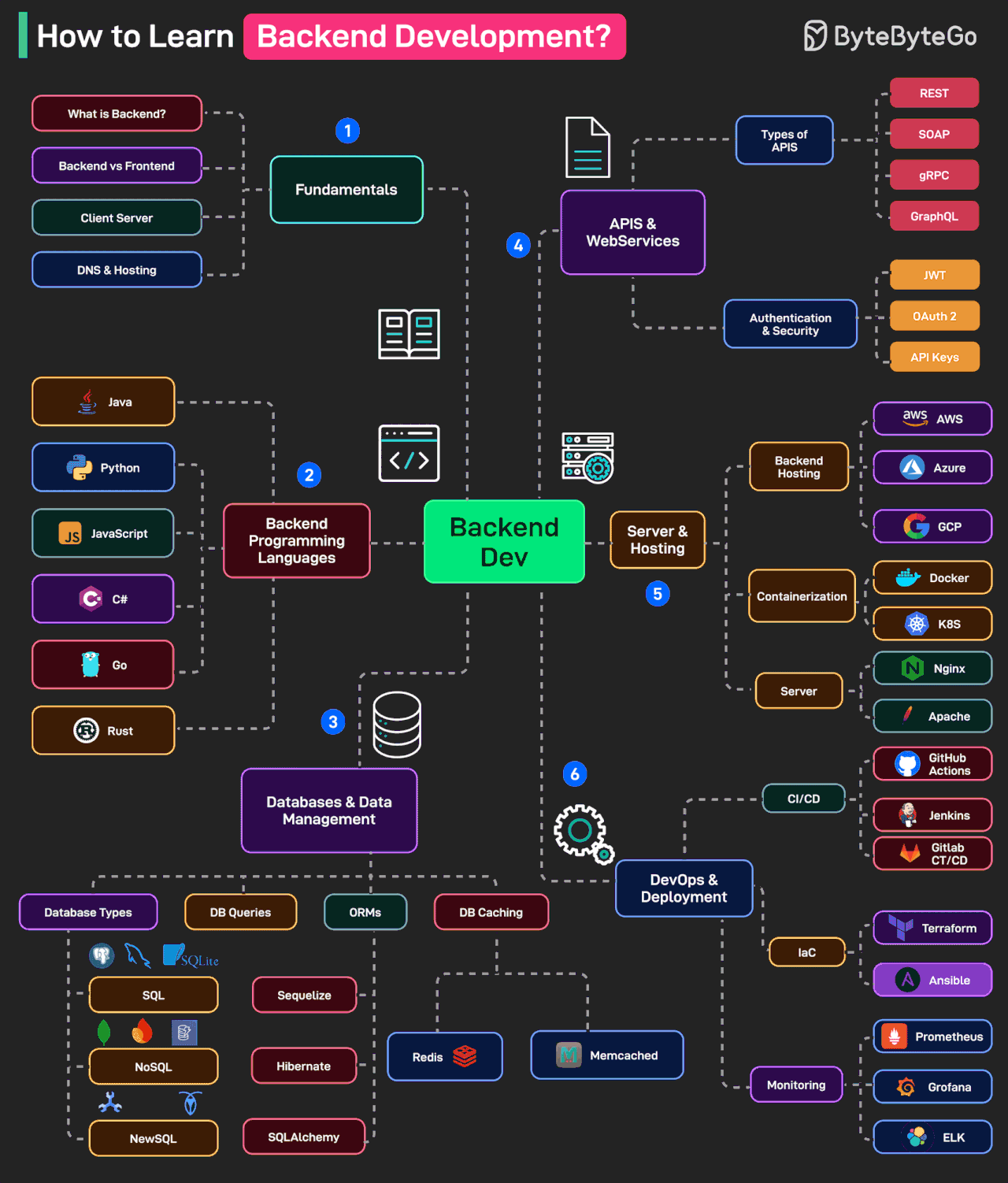Navigating the Backend: A Learning Roadmap Inspired by ByteByteGo
Stepping into backend development can feel like navigating a vast ocean. With so many technologies, concepts, and tools, knowing where to begin or what to learn next is challenging. Thankfully, guides exist to chart the course, and the folks at ByteByteGo recently shared a helpful mind map outlining the key domains involved.
Backend development is the engine powering modern applications, handling everything from data storage and business logic to security and communication. Mastering it requires a broad skill set. Let’s break down the areas highlighted in the ByteByteGo roadmap:

- Fundamentals: Before diving deep, grasp the basics. Understand the difference between frontend and backend, the client-server model, how DNS works, and the general flow of web requests.
- Programming Languages: Choose your tools. Backend logic needs a language. Popular choices include Java, Python, JavaScript (Node.js), Go, Rust, and C#. You’ll likely specialize in one or two but understanding the landscape is key.
- Databases: Data is central to most applications. Learn about different database paradigms:
- SQL: Relational databases like Postgres, MySQL, SQLite.
- NoSQL: Non-relational options like MongoDB, Firebase, DynamoDB.
- NewSQL: Modern relational databases designed for scale, like CockroachDB or Spanner. Also crucial are understanding Object-Relational Mappers (ORMs) and database caching strategies.
- APIs & Web Services: Applications need to communicate. Understand how to design, build, and consume APIs. Learn about different styles (REST, GraphQL, gRPC, SOAP) and essential authentication/authorization methods (JWT, OAuth 2.0, API Keys).
- Server & Hosting: Your backend code needs a place to run. Explore:
- Cloud Providers: Major platforms like AWS, Azure, and GCP offer various hosting services.
- Containerization: Technologies like Docker and orchestration tools like Kubernetes are vital for packaging and managing applications consistently.
- Web Servers: Understand how servers like Nginx or Apache handle requests and serve content.
- DevOps: Modern development involves operational practices. Get familiar with:
- CI/CD: Continuous Integration and Continuous Deployment pipelines automate testing and deployment (e.g., using GitHub Actions, Jenkins).
- Infrastructure as Code (IaC): Manage infrastructure programmatically (e.g., using Terraform, Ansible).
- Monitoring: Keep an eye on your application’s health and performance (e.g., using Prometheus, Grafana, ELK stack).
Summary & Key Takeaways
Backend development is a multifaceted discipline requiring continuous learning. This roadmap provides a structured overview of the essential knowledge domains:
- Start with strong fundamentals.
- Master at least one programming language suitable for backend tasks.
- Understand various database types and data management techniques.
- Learn how to build and secure APIs for communication.
- Know how to deploy and manage applications using modern hosting and containerization solutions.
- Embrace DevOps practices for efficient and reliable software delivery.
Related Resources
- ByteByteGo Blog: https://blog.bytebytego.com/ (Check out their content for deep dives into system design concepts often relevant to backend development).
Food for Thought
Which area of backend development outlined in this roadmap do you find most challenging or intriguing? For experienced developers, what other crucial skills or topics would you add to this learning path?
This post summarizes a learning roadmap presented by ByteByteGo.
Original Source: ByteByteGo. (2023, April 19). EP157: How to Learn Backend Development? ByteByteGo Blog. Retrieved from https://blog.bytebytego.com/p/ep157-how-to-learn-backend-development?ref=dailydev